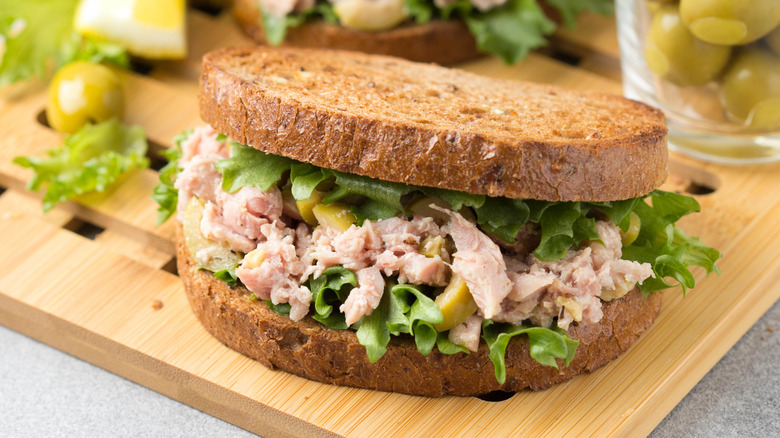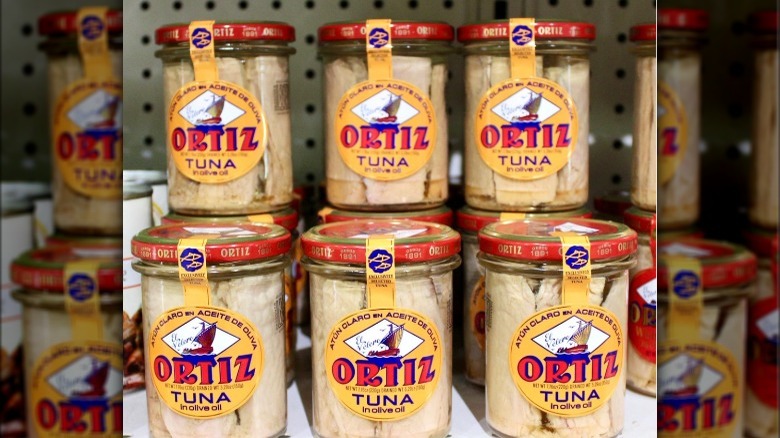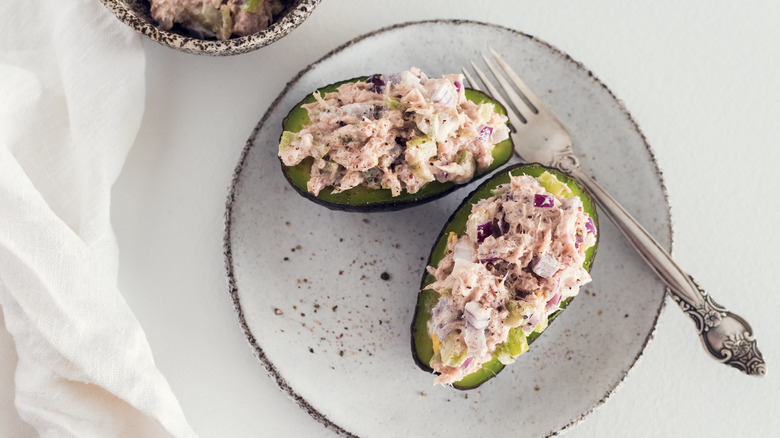Why You Should Use Oil-Packed Tuna For Your Tuna Salad
Every tuna salad lover has their preferred way of making the dish. Popular varieties include the classic deli mayo and celery version and Vietnamese bánh mì-style, per The Kitchn. Some may even prefer Rachael Ray's tuna salad recipe, which has an unexpected ingredient.
Part of tuna salad's popularity is that it's just so accessible — more than half of Americans have at least three pouches of tuna in their pantry at any given time, per SeafoodSource. (It's worth noting that if you're not keeping it in a cool cabinet and checking to make sure it hasn't gone bad, you might be storing your canned tuna wrong.)
The next time you open the cupboard to prep a tuna salad sandwich, there are some pretty good reasons to use fish that's been packed in oil instead of canned in water. So, what's so special about fish packed in oil, and why should you ditch the water-packed cans?
Oil-packed tuna equals a more tender, rich salad
The main reason to select oil-packed tuna over water-packed is moisture. Water-packed tuna tends to lead to a dry salad, warns Steve Cook of the Philadelphia restaurant Zahav, per Taste. Oil-packed tuna, meanwhile, retains the rich texture of confited protein. This can even help your dishes taste closer to a fine-dining menu, as Cook told Taste in 2018 that his now-closed deli, Rooster, prepared its tuna confit in-house rather than using canned fish.
If your primary concern is health, there are arguments to be made for both varieties of canned tuna. Water-packed tuna retains more omega-3 fats than oil-packed tuna because the nutrient drains away with oil but not water, per Livestrong. At the same time, vitamin D content is significantly higher in oil-packed tuna. But one thing to know before you take another bite of canned tuna is that certain other fish, like sardines and salmon, naturally have higher omega-3 concentrations than tuna, per 9Honey, another vote for Steve Cook's method of combining fish.
So the next time you're craving tuna, know that you can still eat healthy without serving a dry and flaky salad on your lunch menu.
Chefs know how to choose the right tuna
Even some of the biggest names in the food world swear by oil-packed tunas. For example, it's all "Barefoot Contessa" host Ina Garten uses in her signature tuna melt. "Basically a tuna sandwich with the volume turned way up," she said in a cooking demo. "Spanish tuna is packed in olive oil, but it's big pieces and absolutely delicious. It's moist and the flavor is fantastic." Chef Chris Cosentino, a "Top Chef Masters" winner who hosted a Food Network show inspired by "Man v. Food," also recommends oil-packed tuna for recipes like his easy spaghetti with canned tuna, per Bon Appetit.
Kitchen expert Daniel Gritzer recommends using ventresca, a fatty belly cut, which he says creates an incomparable texture, per Serious Eats. Brand-wise, Bon Appetit recommends options such as Genova, Tonnino, Bela, and Ortiz, which offer a variety of cuts and oils in both tins and jars. And select brands with the "pole and line caught" label if you've got sustainability in mind.
Don't leave the fish aisle with only tuna, either: Steve Cook of the Philadelphia restaurant Zahav recommends going one step further and beefing up your oil-packed tuna with other oily fish such as sardines to give it an extra punch, per Taste.
What else should you put in your tuna salad?
By now, you're probably sold on the importance of oil-packed fish. But there are still plenty of other ways you can upgrade the ingredients for your next tuna salad. Instead of using mayonnaise as a binder, Women's Health recommends choosing Greek yogurt and Dijon mustard. And to take it one step further, sautée your canned tuna in garlic olive oil. In fact, mayo is the main tuna salad ingredient you should consider swapping out — potentially for tangy and probiotic-rich yogurt, but also for nutritious alternatives like avocado, which you can mash with lemon and cilantro for a guacamole-inspired flavor profile.
And if your tuna salad has a consistency that's a little too wet, you won't immediately be swimming with the fishes; you can salvage your lunch with a few quick additions. Adding hard-boiled eggs makes fixing watery tuna salad easier than you might think, as they can help absorb excess moisture, per The Cooking Bar. You can also try adding starches such as potato, croutons, and pasta, per Julie's Cafe Bakery, which not only lend textural variety but can also create a heartier meal.
When you're ready to serve, don't reach for a loaf of white bread: It can't handle hefty tuna salad as well as multigrain or sourdough slices can, per Epicurious. Now that you've food-hacked your way to the perfect tuna salad sandwich with sustainable oil-packed fish, it's time to plan a picnic!



